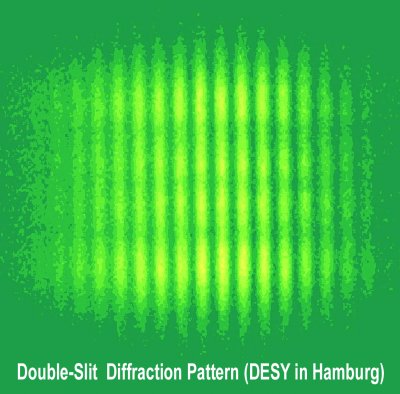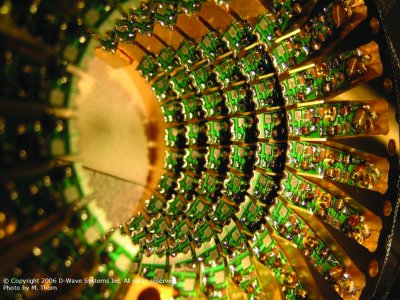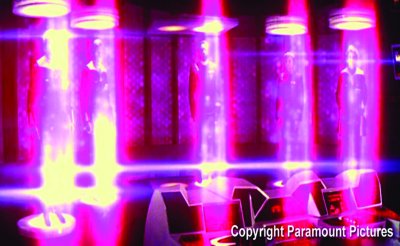|
The Quantum Conundrum
 Mention
Quantum Physics to most people and their eyes will glaze over or
they’ll just admit to knowing nothing about it – or both! Generally
considered as a ‘new’ science, Quantum Theory actually has its roots
going back almost two hundred years to the experiments of Michael
Faraday. In the 1900s, Max Planck and Albert Einstein made further
advances in understanding Quantum Mechanics. Quantum Physics,
Quantum Mechanics, Quantum Theory – there’s confusion right off the
bat! What the heck are we talking about? For the rest of this
article, we’ll use the term Quantum Theory and abbreviate it down to
QT (which, for some reason brings forth an image [perhaps a quantum
image?] of Quentin Tarantino, but never mind). Mention
Quantum Physics to most people and their eyes will glaze over or
they’ll just admit to knowing nothing about it – or both! Generally
considered as a ‘new’ science, Quantum Theory actually has its roots
going back almost two hundred years to the experiments of Michael
Faraday. In the 1900s, Max Planck and Albert Einstein made further
advances in understanding Quantum Mechanics. Quantum Physics,
Quantum Mechanics, Quantum Theory – there’s confusion right off the
bat! What the heck are we talking about? For the rest of this
article, we’ll use the term Quantum Theory and abbreviate it down to
QT (which, for some reason brings forth an image [perhaps a quantum
image?] of Quentin Tarantino, but never mind).
QT is often
said to be the theory of very small objects, particles much smaller
than atoms. This is true for the most part, except that quantum
particles don’t always behave like particles. Sometimes they behave
like waves. No wonder we can’t get to grips with QT when things in
that realm don’t even know what they are themselves!
Probably
the most well-known quantum particle is the photon. A photon is a
particle of light and, like all quantum particles (quanta), it can
also display the properties of a wave. A wave can be refracted or
bent while a particle cannot, being limited to transferring energy
when coming into contact with matter. There are also many other
types of quantum particles such as quarks, neutrinos, leptons and a
hatful of others.
One of the
things that differentiates quanta from atomic matter (i.e. you and
me or that rose bush in the garden) is its ‘spooky’ qualities.
Quanta can seemingly appear from nowhere, they can be in two places
at once and an effect on one quantum particle can transfer to other,
identical quanta that are totally isolated. For instance, a quantum
particle can be made to spin in the opposite direction to its normal
state and identical particles completely separate will do likewise.
This is what has become known as quantum entanglement. It should
also be noted that because of the uncertain nature of quanta (as
postulated by Werner Heisenberg in his famous Uncertainty
Principle), they are not measured in definite terms, but as measures
of probability. This also links in with the so-called Observer
Effect (although they are separate theories), where the mere act of
observing an object affects the nature or actions of the object.
 A
famous experiment, known as the Double-Slit Experiment, suggested
that quanta can exist in two places at once. Two slits were set in a
solid plate. When one slit was opened, and photons were fired
through only a narrow diffraction pattern was seen. When both slits
were opened and photons passed through, as expected, they created a
wider interference pattern on the photographic plate beyond the
slits. A
famous experiment, known as the Double-Slit Experiment, suggested
that quanta can exist in two places at once. Two slits were set in a
solid plate. When one slit was opened, and photons were fired
through only a narrow diffraction pattern was seen. When both slits
were opened and photons passed through, as expected, they created a
wider interference pattern on the photographic plate beyond the
slits.
Now here
comes the spooky bit. When only a single photon was fired towards
the slits, an interference pattern was seen on the photographic
plate. This means that, somehow, this single photon had to be in two
places at the same time to pass through both slits. Further
experiments have led to the theory that the single photon must pass
through every point in space-time to get to the photographic
plate.
Recently,
experiments with larger molecules (fullerenes) have resulted in
quantum interference patterns when just one molecule has been
utilised. Further experiments are to be attempted (or may already
have been attempted) with viruses, which are twenty to three hundred
times the size of a molecule. This has led to the notion that QT is
not just the theory of very, very small things, but it is also a
theory of isolated things. Basically, if you could isolate yourself
from the rest of the universe, you could appear in two places at the
same time. If Dr Richard Feynman’s calculations are correct, you
could actually exist in all of space and all of time simultaneously!
Okay, so
how does this affect the study of UFOs?
UFOs and
the beings that travel inside them have often been reported as
winking out and appearing somewhere else almost simultaneously. The
so-called Greys and other entities have been reported as appearing
out of nowhere in abductees/contactees houses, often passing through
seemingly solid objects. Often the passage of time has been
interrupted or affected in some way. All of these effects suggest
some kind of manipulation of what we call Quantum Theory. More
advanced extra-terrestrial (or perhaps extra-dimensional) species
may have gone beyond theory and made practical use of the quantum
realm. Heck, given that the laws of space-time as we know them
appear to have little or no effect in quantum mechanics, could these
aliens exist outside of space-time? Are they from everywhere and
nowhere? Are they from the past, the present, the future, or do they
exist in all times? If so, what effect would this have on us plebs
stuck in a linear timeline? Have they affected our history and, if
so, would we know about it anyway?
 While
this all seems pretty far-fetched and fantastic, it is all very
possible within the contexts of QT. Will humanity ever be able to
adapt quantum theory into our technology? We already do to a certain
extent, with many of our electronic devices displaying quantum
mechanics in their operation, such as the laser and the magnetic
resonance image (MRI) scanner. Can we go further, though? While
this all seems pretty far-fetched and fantastic, it is all very
possible within the contexts of QT. Will humanity ever be able to
adapt quantum theory into our technology? We already do to a certain
extent, with many of our electronic devices displaying quantum
mechanics in their operation, such as the laser and the magnetic
resonance image (MRI) scanner. Can we go further, though?
There are
efforts to create quantum computers, which would be able to perform
calculations much, much faster than today’s machines, perhaps being
able to give an answer to a question, no matter how complex, as soon
as it is submitted.
Looking
farther ahead, might QT be able to allow us to travel to other
planets? This may be possible. If you can isolate a person from the
outside universe, it may be possible to transport them to any place
in space and any point in time you desire. In a quantum state, the
person would exist in all of space-time simultaneously, getting them
to appear where they wanted to go may only be a matter of
fine-tuning.
 I
know, I know, this all sounds like the science fiction of Star Trek,
but recall the words of Arthur C Clarke: “Any sufficiently advanced
technology is indistinguishable from magic.” I
know, I know, this all sounds like the science fiction of Star Trek,
but recall the words of Arthur C Clarke: “Any sufficiently advanced
technology is indistinguishable from magic.”
Or perhaps
Einstein got closer to the truth with, “reality is an illusion,
albeit a persistent one.”
©
Steve Johnson -
2008
|